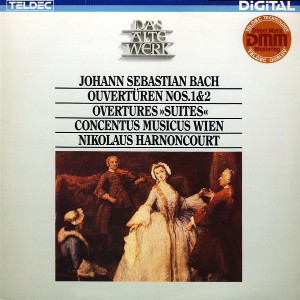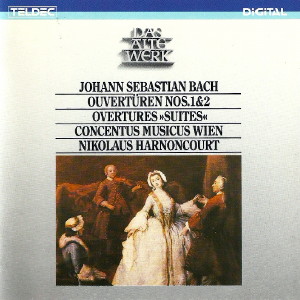 |
1 LP -
6.43051 AZ - (p) 1984
|
 |
| 1 CD -
8.43051 ZK - (p) 1984 |
|
| Johann
Sebastian Bach (1685-1750) |
|
|
|
|
|
|
|
| Ouvertüre (Suite) Nr. 1
C-dur, BWV 1066 |
|
27' 40" |
|
| - Ouverture |
10' 51" |
|
A1 |
- Courante
|
2' 54" |
|
A2 |
| - Gavotte
I alternativement / Gavotte II |
3' 04" |
|
A3 |
| - Forlane |
1' 20" |
|
A4 |
- Menuet I
alternativement / Menuet II
|
3' 52" |
|
A5 |
| - Bourrée I
alternativement / Bourrée II |
2' 12" |
|
A6 |
| - Passepied I / II |
3' 27" |
|
A7 |
| Ouvertüre (Suite) Nr. 2
h-moll, BWV 1067 |
|
22' 55" |
|
- Ouverture
|
11' 37" |
|
B1 |
| - Rondeau |
1' 34" |
|
B2 |
| - Sarabande |
3' 03" |
|
B3 |
| - Bourrée I alternativement
/ Bourrée II |
1' 49" |
|
B4 |
- Polonaise / Double
|
3' 00" |
|
B5 |
| - Menuet |
1' 27" |
|
B6 |
| - Badinerie |
1' 25" |
|
B7 |
|
|
|
|
CONCENTUS MUSICUS WIEN (mit
Originalinstrumenten)
|
|
| -
Leopold Stastny, Flûte
traversière |
-
Andrea Bischof, Violine (1066)
|
|
| -
Jürg Schaeftlein, Oboe |
-
Karl Höffinger, Violine (1066)
|
|
| -
Marie Wolf, Oboe |
-
Helmut Mitter, Violine (1066) |
|
| -
Milan Turković, Fagott |
-
Kurt Theiner, Viola |
|
| -
Alice Harnoncourt, Violine |
-
Josef de Sordi, Viola (1066) |
|
| -
Erich Höbarth, Violine |
-
Nikolaus Harnoncourt, Violoncello |
|
-
Anita Mitterer, Violine (1066)
|
-
Eduard Hruza, Violone |
|
| -
Peter Schoberwalter, Violine
(1066) |
-
Herbert Tachezi, Cembalo |
|
|
|
| Nikolaus
Harnoncourt, Leitung |
|
|
|
Luogo
e data di registrazione
|
| Casino Zögernitz,
Vienna (Austria) - dicembre
1983 |
|
Registrazione
live / studio
|
| studio |
Producer
/ Engineer
|
-
|
Prima Edizione CD
|
-
Teldec "Das Alte Werk" - 8.43051 ZK - (1
cd) - 51' 35' - (p) 1984 - DDD
|
|
Prima
Edizione LP
|
- Teldec "Das
Alte Werk" - 6.43051 AZ - (1 lp) - 51'
35"
- (p) 1984 - Digital
|
|
|
Notes
|
The musical term suite
means a row, a sequence of pieces, in
fact primarily of dances. Bach
himself, it must be
said, never named his suites thus, but
used the name of the weighty
introductory movement, “Ouverture”, as
the title of the entire work.
Nevertheless, they are genuine suites
which count among the
last works of this ancient category.
Through the extension of the
dominating introductory movement, the
overture, to half the length of the
entire work, Bach elevated his suites
from the sphere of light "table music"
and formed them into genuine works of
“worldly” festive music. The elements
of greatness and splendour are
underlined by the constitution of the
orchestra in the 1st,
3rd and 4th suites. The dances and
charaeteristic pieces follow the
overture according to a brilliant plan
of dramatic significance.
In the C major Suite, a beginning is
made by a nostalgic, song-like
courante in the French manner. This
lcgato piece is followed, as if the
reins were being let looser, by a gay
gavotte (in which. in accordance with
Muffat’s demands, the second and
fourth crotchet “should be far more
restrained than hurried”); this
intensification finds its climax in a
wild southern forlana. Constant quaver
movement in the middle parts is here
intended to represent the excited
crowd of spectators. This most
unbridled and folk-like of all Bach`s
dances is followed, in most extreme
contrast. hy a minuet. the court dance
“par excellence." ln a self-contained
symmetrical sequence (a kind of
miniature suite in itself) -
minuet/bourrée/passepicd
(a quick variety of minuet) -
the spirits that have become so heated
by the forlana are calmed again, and
made "fit for the court" once more. In
addition, the two last dances
represent a symmetrical final
reflection of the first two: courante
(song-like) and gavotte (refinedly
dance-like) are corresponded to by the
bourrée and
passepied. These two dances are
closely related to the first two, the
bourrée
being the more lively sister of the
gavotte and the passepied, a
peculiarly song-like variety of this
dance form, recalling the courante.
It differs markedly from the usual
pattern, its
expressly legato
quaver figures in the first section
and even more so in the Passepied II
(in the oboe solo) imparting a
flowing, cantabilc quality to the
piece. The hemiole
finesses of the traditional passepied
are suggested in the background in
this piece.
In the B minor Suite, the
intensification of expression of the
individual dances is perhaps still
more clearly marked. The sequence of
dances begins with a discreetly noble
Rondeau
(a gavotte) and rises to powerful
expression in the measured striding of
the Sarabande. The impetuous Bourrée I
and the delicate Bourrée II bring
a further intensification, which finds
its goal in the grandiose and proud Polonaise.
The latter’s “Double” is at the same
time the virtuoso climax of the flute
solos in this suite. Again the
classical Minuet
follows as an elegant calming
influence. Since, however, this suite
is truly speaking a flute
concerto, the impudent, coquettish
Badinerie is tacked on as a bravura
piece for the flute - a ready-
composed encore, as it were.
|
|
Nikolaus
Harnoncourt (1929-2016)
|

|

|
|